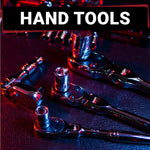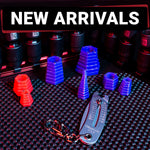Split beam wrenches tighten bolts and nuts to an exact torque value. These torque tools click and split at the joint when they reach the preset torque, so you get the right torque no matter the tool's angle or position. You’ll pay more for these precision tools but get superior accuracy. A split beam design resists wear and maintains calibration far longer than traditional torque wrenches.
We'll explain what makes split beam torque wrenches the best choice for automotive torque specifications and why professionals trust these professional-grade torque wrenches.
The Advantages of Split Beam Torque Wrenches
- High accuracy: These torque wrenches maintain a ±2% accuracy tolerance, which tops many click-style torque wrenches.
- Bi-directional torque reading: Many split beam wrenches measure torque in clockwise and counterclockwise directions.
- Simple operation: The scale shows exact torque readings without referring to conversion charts.
- Consistent calibration: The split beam design maintains accuracy and calibration longer than click-type wrenches.
- Lock function: The lock function prevents accidental torque changes.
Disadvantages of Split Beam Torque Wrenches
Split beam torque wrenches cost more than basic models but offer professional-grade performance. Their main disadvantage comes from the need for users to watch the scale continuously as they work instead of receiving automatic notification when they reach the target torque.

How To Use Split Beam Torque Wrenches
Confirm the wrench reads zero on the scale. A split beam torque wrench must point to zero when you hold it level and straight. If the scale shows anything else, a calibration check is required.
Find the torque spec you need in your service manual; never guess at torque values. split beam wrenches show torque directly on the scale. Set your target torque, and do not exceed the maximum torque rating.
The actual torque process requires these steps:
- Attach the correct socket to your wrench.
- Position the wrench straight and level on the fastener.
- Apply force smoothly and steadily.
- Watch the beam pointer as you tighten.
- Stop immediately when you reach your target torque.
Split Beam Torque Wrench Maintenance
Regular maintenance keeps a split beam torque wrench performing accurately and extends its lifespan. Follow these steps to maintain your tool:
- Clean after use: Wipe the wrench with a soft cloth or tool wipes to remove dust, oil, and debris. Avoid harsh chemicals that can damage the finish.
- Check for physical damage: Inspect the handle, scale, and head regularly for signs of wear, cracks, or misalignment.
- Store properly: Keep the wrench in a dry, protective case or tool organizer to prevent exposure to moisture and impact damage.
- Avoid excessive force: Never use the wrench as a breaker bar or for loosening bolts, as this can affect calibration and cause premature wear.
Split Beam Torque Wrench Calibration
To maintain accurate torque readings, you need periodic calibration checks. Calibration makes sure the wrench delivers consistent torque and meets industry standards.
Here are some things to know about torque wrench calibration:
- Regular calibration checks: Most manufacturers recommend a calibration check every 5,000 cycles or at least once a year, depending on usage.
-
Signs calibration is needed:
- Inconsistent torque readings
- The wrench fails to click or release at the correct target torque
- A noticeable shift in accuracy over time
- Certificate of calibration: When sending the wrench for professional calibration, request a calibration certificate to verify accuracy.
- Calibration before shipping: If purchasing a new wrench, check if it comes with factory testing and an initial calibration sheet.
- DIY calibration check: While professional calibration is recommended, some users perform a basic check using a bench vice and a measured weight for verification.
Regular maintenance and calibration keep a split beam torque wrench reliable and accurate. With proper care, these precision instruments provide years of dependable service.
Split Beam vs. Click Style Torque Wrenches
|
Split beam torque wrench |
Click type torque wrench |
|
|
Accuracy |
±2–4% |
±4–6% |
|
Internal parts |
Separate measuring beam, minimal moving parts |
Springs, pins, clicking mechanism |
|
Price |
$120–300 |
$30–150 |
|
Feedback method |
Visual deal reading, and audible click |
Audible click |
|
Storage requirements |
Must stay level in case |
Any position after zeroing |
|
Best for |
Precise work requiring consistent accuracy |
Basic torque applications |
Your choice depends on your work:
- Buy a split beam style wrench for engine rebuilds, cylinder heads, and jobs where exact torque affects safety or warranty.
- Get a click wrench for basic maintenance, brake jobs, and general repairs where being within 5% of spec works fine.
Professional mechanics often keep both; a click wrench for quick jobs, and a split beam for precision work.
Check out our comparison about click type vs. split beam torque wrenches.
Buy Olsa Tools Split Beam Torque Wrench
Stop the guesswork and protect your fasteners with exact torque every time. The Olsa Tools split beam torque wrench meets ±4% CW DIN ISO accuracy standards for heavy shop work, which provides professional-grade accuracy at a competitive price.
We construct each wrench with premium materials and stand behind it with our lifetime warranty. This torque wrench offers the reliability DIY mechanics need without the premium price tag that professional brands charge.
Shop our split beam torque wrench.
Split Beam Torque Wrench FAQ
Does a split beam torque wrench make a loud-click sound like click type models?
split beam torque wrenches produce an audible click sound when the desired torque is reached, similar to click type models. This distinct sound and visual split in the beam provide clear feedback to users.
Are flex-head torque wrenches available in split beam designs?
Some manufacturers offer flex-head torque wrenches in split beam designs. A flexible head provides improved access to fasteners in hard-to-reach spaces.
How do digital torque wrenches compare to split beam models?
Digital torque wrenches use electronic sensors to measure torque and often provide an audible tone or LED display for precision. While they offer adjustable settings and high accuracy, they require batteries and are more susceptible to damage. split beam wrenches have a sturdy construction and require less maintenance.
What types of torque wrenches are there?
There are several types of torque wrenches, including:
- Click type models are the most common type that produces a click at the preset torque level.
- split beam torque wrenches maintain accuracy over time with a calibratable indicator.
- Electric torque wrenches are also called digital torque wrenches; they display real-time torque readings.
- Beam-type wrenches use a simple beam and dial system.
- Flex-head torque wrenches feature a pivoting head for better access.
What drive sizes are available for split beam torque wrenches?
You can find common 1/4, 3/8, and 1/2-inch drive torque wrench options at most stores. Specialty shops might carry additional drive sizes. These sizes cover a complete torque range. Socket adapters further expand compatibility.
What is the torque range of a split beam wrench?
The torque range of a split beam wrench varies by manufacturer and model. Typically, it can range from 20–250 ft-lbs or more, depending on the size and specific design. For example, Olsa Tools 1/2-inch drive split beam torque wrench might offer a 50–250 ft-lbs range. These wrenches maintain accuracy across their entire torque range.
Are split beam torque wrenches made of chrome-vanadium steel?
Most high-quality split beam torque wrenches are made from chrome-vanadium steel for sturdy construction and comfortable grip. Some models feature ergonomic grips to reduce hand fatigue during extended use.
Can I use a split beam torque wrench to loosen bolts?
Using a drive split beam torque wrench to loosen bolts can cause accuracy loss and damage the internal mechanism. Always use a breaker bar for loosening fasteners.
Why do split beam torque wrenches cost more?
The precision torque design and durable materials make these wrenches a premium option. Their adjustable settings, calibratable indicators, and long-lasting accuracy justify the higher cost.








